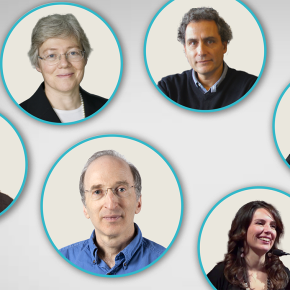
The CNRS invites the world's greatest minds
Celebrated figures from global research will join the CNRS as "fellow-ambassadors." A new instrument that demonstrates the organization's renown.
"I am honored and delighted to have this new opportunity to continue and develop further my long standing highly productive collaborations with my many CNRS colleagues," affirms Saul Perlmutter. The winner of the 2011 Nobel Prize in Physics for his discovery that the expansion of the Universe is accelerating,1 the American cosmologist is one of the first ten very high-level scientists invited to become "CNRS fellow-ambassadors."
Rooted in the academic tradition of eminent "visiting professors," this new CNRS instrument has two complementary objectives. First, "the quality of world-class scientists that participate demonstrates the attractiveness of the CNRS, doing so in a way that goes beyond a simple speech," assures Alain Schuhl, the organization's Chief Scientific Officer.
Second, the programme seeks to energize French research: "We can take advantage of the CNRS's standing and renown to draw the world's greatest scientists," explains Schuhl. These prestigious researchers, invited via proposals from CNRS institutes, commit to spending at least one month per year for a period of three years in one or more laboratories in France.
"By being present over a long-term basis within a laboratory, a 'fellow-ambassador' becomes more accessible and available to interact with French researchers on scientific issues, and more broadly on how to approach research," points out Reynald Pain, the Director of the CNRS's National Institute of Nuclear and Particle Physics (IN2P3), who invited Saul Perlmutter. These high-calibre figures can in particular assume a support role "more spontaneously with younger scientists and doctoral students, who may not have had the opportunity to meet them in a conference." "Many foreign scientists admire the CNRS, its scientific activity, and the excellence of its researchers," adds Pain.
All of the ambassadors in this first class have permanent positions abroad, in addition to substantial scientific relations with French scientists. For example, Saul Perlmutter is the co-director of the Pierre Binétruy Centre, an International Research Laboratory (IRL2 ) established between the CNRS and the University of California at Berkeley thanks to his efforts. Alejandro Maass played a decisive role in developing the Center for Mathematical Modeling with the Universidad de Chile, the CNRS's first IRL in this country. The Italian astrophysicist Marica Branchesi, who in 2018 was included on Time magazine's list of the world's 100 most influential figures, was highly involved in the Virgo collaboration—especially the Advanced Virgo instrument—which was co-funded by the CNRS in France and the Istituto Nazionale di Fisica Nucleare (INFN) in Italy. Another example is Anne L'Huillier, who is originally from France and now a professor at Lund University in Sweden, and who has received many prizes for her research in atomic physics.
The Director of the Centre of Heritage and Museum Studies at the Australian National University, Laurajane Smith studies the politicization of heritage, a major subject in anthropology, which is a scientific priority for the CNRS's Institute for Humanities and Social Sciences (INSHS). "The CNRS's international policy is a major aspect of the organization's identity," reminds Marie Gaille, the director of the institute. The research conducted at the CNRS is thus "highly internationalized"—two-thirds of CNRS co-publications are in partnership with a foreign laboratory—and numerous scientists have "strong and enduring ties with colleagues abroad that structure their research," Gaille elucidates. "In the wake of foreign colleagues who showed their attachment to the institution during the CNRS's 80th anniversary in 2019, this more enduring instrument for developing international ties emphasizes the importance of such relations."
This selective instrument will give the CNRS access, once the first classes overlap, to thirty internationally recognized scientists each year, in the service of its scientific community and visibility.
The 10 fellow-ambassadors for 2023:
- Marica Branchesi, astrophysicist, Gran Sasso Science Institute, Italy
- Francesco dell’Isola, researcher in theoretical mechanics, Università degli Studi dell’Aquila, Italy
- Maurice Herlihy, computer scientist, Brown University, United States
- Anne L’Huillier, atomic physicist, Lund University, Sweden
- Alejandro Maass, mathematician, Universidad de Chile, Chile
- Krzysztof Matyjaszewski, polymer chemist, Carnegie Mellon University, United States
- Leonid Alex Mirny, biophysicist, Harvard, United States
- Jeffrey F. Morris, professor of chemical engineering, City College of New York, United States
- Saul Perlmutter, physicist, University of California, Berkeley, United States
- Laurajane Smith, researcher in heritage and museum studies, Australian National University, Australia


